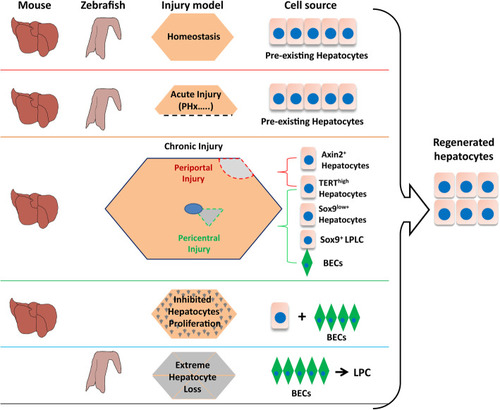- Title
-
All routes lead to Rome: multifaceted origin of hepatocytes during liver regeneration
- Authors
- Gao, C., Peng, J.
- Source
- Full text @ Cell Regen (Lond)
|
A cartoon for comparing origin of hepatocytes during liver homeostasis and regeneration in mouse and zebrafish. Liver initiates different regeneration modes in response to different degrees of damages. Proliferation of embryonic hepatocytes make main contribution to hepatocytes in a normal adult liver. Proliferation of mature hepatocytes are responsible for maintaining hepatocyte homeostasis in a normal adult liver and recovery of liver mass after acute injuries such as PH (top two panels). Chronic injuries near the periportal region (periportal injury) will probably activate the Axin2+ cells around central vein to produce new hepatocytes (highlighted in red, third panel). In contrast, chronic injuries around the central vein region (pericentral injury) seems to mobilize Sox9low+ or/and Sox9+ LPLC hepatocytes around periportal region to generate new hepatocytes (highlighted in green, third panel). As the degree of damage increases, such as treating mouse with TAA for 24 weeks, biliary epithelial cells (BECs) start to make contribution to the production of hepatocytes through direct lineage conversion (third panel). It is proposed that TERThigh hepatocytes might be a universal cell source for liver regeneration under periportal, pericentral or other injury conditions (third panel). Impaired proliferation ability of hepatocytes, such as in the case of |

